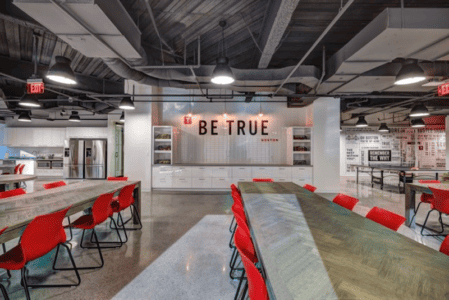As companies of all sizes start to think about what it will be like to return to more frequent in-person work, the lessons of a year of remote productivity have many rethinking priorities and considering reducing the office footprint. But according to workplace design experts, cafeterias and pantry amenities might actually expand in size even as areas devoted to workstations shrink.
At Dyer Brown, a Boston-based architectural firm, Karen Bala, AIA, LEED AP, director of design for workplace strategy experts, says, “So many of us have grown used to handling tasks and videoconferencing from the kitchen table. A well-appointed cafeteria has everything that most of us need to get our work done, including space for informal meetings. With more companies considering a hybrid remote/in-person model to reduce their workplace footprint, cafeteria and pantry amenities are a potent use of square footage.”
“For many, the opportunity to ‘break bread’ with colleagues and clients is a major incentive to return to in-person work,” Bala adds. “More than ever, the office is for eating.”

To Bala’s point, modern food service areas typically offer WiFi and integrated connections for powering laptops and devices and provide a setting for socializing and informal collaboration, which most of us are looking forward to after a year of relative isolation. Drawing from Dyer Brown’s recent work for building owners and individual companies ranging from small firms to global Fortune 500 brands, she suggests a few trends to watch for in this area:
The cafeteria as flex-space. Lightweight movable furnishings allow the cafeteria or pantry to be quickly reorganized for all-hands meetings, training sessions, and even low-impact fitness classes. “The furniture should also offer a variety of seating and table heights,” says Bala, “to accommodate different work styles.” At the same time, many commercial property owners are investing in integrated workplace management systems (IWMS) that allow tenants to alert building staff that a planned event will require a reconfiguration.
The showcase space. Large employers may build on the flexibility idea by foregrounding a brand-inspired, design-forward cafeteria, placed strategically near a lobby or another visitor-focused area. Making the cafeteria more visible presents a window into the company culture. In some cases, this showcase venue can double as an event space.
Healthful, local cuisine. Building owners and major employers are increasingly considering turning over food service operations to companies like Fooda that started out as pop-up “virtual cafeteria” services. These operators partner with local restaurants and other providers to offer a variety of healthy, appealing menus, rotating in new cuisines daily. To address social distancing, these companies help out employers with apps for ordering and reserving a spot at a table.
Herman Miller Hires Local Culinary Talent
At Herman Miller, all food service has been brought in-house with the Zeeland, MI furniture company bringing food service in-house, hiring displaced culinary talent and sourcing more local, sustainable food to serve its West Michigan employees. The company has hired four chefs and will grow the team to over 20 food service members — many of whom recently lost their service industry jobs due to COVID-19 lockdowns.
According to the Michigan Restaurant & Lodging Association (MRLA), about 5,600 restaurant operators in the state say it is unlikely they’ll be in business within the next six months. That equals 33% of the state’s restaurants.
“That’s a lot of people on the sidelines, and we’re excited to welcome this talented, passionate group of culinary experts to our company,” said Shannon Bell, Herman Miller facilities services manager. “When you think about Herman Miller, you don’t think about food, but it’s a big part of who we are.”

The company’s West Michigan food service began in the 1970s in a response to a national energy crisis — an incentive for employees to utilize corporate ridesharing and reduce the necessity of driving to lunch to save energy. Today, its West Michigan food service capabilities span across five buildings and six cafes. They serve a total of 2,400 team members per day compared to approximately 4,000 before COVID-19 lockdowns. While many of the office-based employees are still working from home, its manufacturing team members have been back on-site since April 2020.
Not only do these culinary experts have a new career at Herman Miller, but they are also making the lives better for their fellow employees and communities.
Sourcing local, sustainable, traceable food. The team of chefs is closely involved in the vendor selection process working with local, regional, and national vendors that match Herman Miller’s brand and sustainability practices. Along the supply chain, they can also trace all food back to its source, tracking environmental impact measures such as fuel efficiency and emissions.
Offering healthier affordable food options. By fueling its employees with healthy food options created within the kitchens, the employees have already noted an increase in morale and energy. And, by keeping the services in-house, the company can control pricing, so employees don’t need to sacrifice healthy options for budget concerns.
Serving the community through food recovery. The food services team works to be as efficient as possible when preparing food, but when there are leftovers, they reach out to a local nonprofit, Community Action House, that picks up the surplus food a redistributes it to those in need.
Creating experiences and connection. No matter how long an employee has for lunch, the cafés have always been more than just a place to eat. These are settings for connection, conversation, and collaboration. The food service team aims to create an elevated experience for anyone who enters the cafés.
Culinary creativity. Culinary creativity is welcomed and celebrated. The team spent months developing menus and programs fit for a variety of customers. From salad dressing and soup, to its now-famous chicken tenders, as much as possible is created from scratch.
“The experience in the café has completely transformed,” said Bell. “At the end of the day, it’s all about people taking care of people, and that’s just what Herman Miller is good at.”





















![[VIDEO] Collect Asset Data at the Speed of Walking a Building](https://facilityexecutive.com/wp-content/uploads/2024/02/maxresdefault-324x160.jpg)
great post